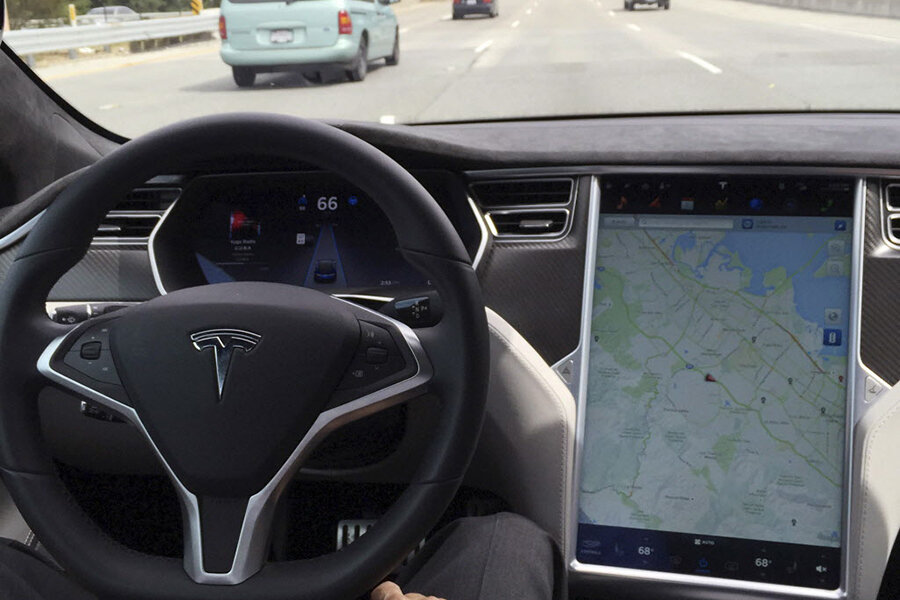Tesla and Fortune battle over coverage of fatal autopilot crash
Loading...
Is it time to do the “bloody math” on whether self-driving cars could pose a safety risk?
Tesla chief executive Elon Musk is ramping up a battle of words this week with the business magazine Fortune. Tesla is callling Fortune's report that the carmaker didn’t publicly disclose a fatal accident that occurred while a driver was using Tesla’s “Autopilot” feature, “fundamentally incorrect.”
On Tuesday, Fortune reported that Tesla sold more than $2 billion of the company’s stock in May without informing the public or investors of the fatal accident that killed 40-year-old Joshua Brown, who was driving a Tesla Model S, earlier that month.
The article, written by veteran financial journalist Carol Loomis, also turned on whether the disclosure of the accident was “material” information that investors should know.
That provoked a stinging response from Mr. Musk, who later called the article “BS." After telling Ms. Loomis in an email that disclosing the accident “is not material to the value of Tesla,” he added:
Indeed, if anyone bothered to do the math (obviously, you did not) they would realize that of the over 1 [million] auto deaths per year worldwide, approximately half a million people would have been saved if the Tesla autopilot was universally available. Please, take 5 mins and do the bloody math before you write an article that misleads the public.
His argument is one frequently cited by proponents of self-driving technology. But researchers have often said that safety tests from the cars should be made more publicly available.
“I think I speak for many in the robotics community to say we’re strong advocates of this technology but if a death, a fatality, were to occur soon, at the wrong time, it could really set back the integration of this technology which I fully think will help prevent those deaths on the road,” Mary Cummings, a robotics professor at Duke University who studies interactions between humans and technology, told lawmakers in Washington at a hearing in March.
On Wednesday, Fortune published a second story suggesting Tesla had contradicted Mr. Musk’s own position by saying in a Securities and Exchange Commission filing in May that a fatal crash related to the semi-autonomous features could be a material event that could “damage [Tesla’s] brand, business, prospects, and operating results.”
That phrase appears to be boilerplate language, reoccurring 14 times in the filing in various contexts. In a blog post on Wednesday, Tesla provided a fuller response challenging the magazine, while also arguing the accident that killed Mr. Brown was a “statistical inevitability.”
“Fortune entirely ignores what Tesla knew and when, nor have they even asked the questions. Instead, they simply assume that Tesla had complete information from the moment this accident occurred,” the company wrote. “This was a physical impossibility given that the damage sustained by the Model S in the crash limited Tesla's ability to recover data from it remotely.”
The post appears to take a tougher stance on culpability for the accident, a significant issue that has prompted some researchers to question whether carmakers should take on more responsibility for an accident in a self-driving car, much as a licensed driver would.
“To be clear, this accident was the result of a semi-tractor trailer crossing both lanes of a divided highway in front of an oncoming car,” the company writes, noting that “there is no evidence to suggest that Autopilot was not operating as designed and described to users.”
Fortune “jumped the gun” on its story without giving the company an extra day to comment, Tesla argues.
The National Highway and Transportation and Safety Administration also delayed disclosing the accident until June 30, according to Fortune.
NHTSA is investigating that crash and a second, non-fatal crash in Pennsylvania involving a Tesla Model X, in order to determine whether Autopilot was in use at the time, Reuters reports.
Fortune says it “fully” stands by its reporting. This is not the first time that Musk has clashed with the press. He has also previously criticized other reporters and stopped speaking to his biographer, reports the Huffington Post’s Alexander C. Kaufman.
A Tesla spokeswoman told the Huffington Post that “Elon’s comments are the comment.” Mr. Kaufman also suggests the Tesla head’s personality may also play a role in the spat.
“But Musk isn’t like other chief executives. He embraces his celebrity,” he writes. “He seems to believe that he has made himself a force for good in the world by bringing affordable electric cars and solar energy to market just as climate change begins to reach crisis levels.”







